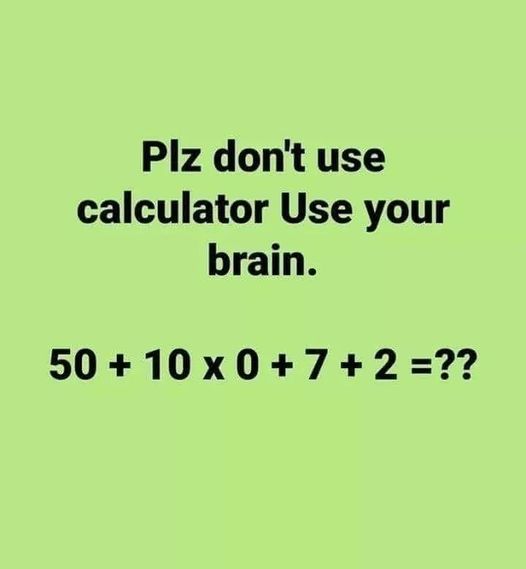A seemingly straightforward arithmetic problem has taken the internet by storm, igniting debates and confusion among people worldwide. The problem appears simple at first glance, but its solution hinges on a crucial understanding of mathematical principles. Here’s the challenge:
50 + 10 x 0 + 7 + 2 = ??
To many, the equation looks like a basic addition and multiplication problem, but the varying answers highlight the importance of following the proper order of operations in mathematics. This simple equation has become a battleground for math enthusiasts and novices alike, each presenting their version of the correct answer.
The Order of Operations: PEMDAS/BODMAS
The primary reason for the discrepancy in answers lies in the order of operations, a fundamental concept in arithmetic. The order of operations is typically remembered by the acronym PEMDAS (Parentheses, Exponents, Multiplication and Division (from left to right), Addition and Subtraction (from left to right)) in the United States, or BODMAS (Brackets, Orders, Division and Multiplication, Addition and Subtraction) in other parts of the world.
Without adhering to this hierarchy, solving any mathematical equation can lead to incorrect results. Let’s break down the problem using the PEMDAS/BODMAS rules:
-
- Parentheses/Brackets: There are none in this equation.
-
- Exponents/Orders: There are none in this equation.
- Multiplication and Division: These operations come next and are performed from left to right.
- Addition and Subtraction: These operations are performed last, from left to right.
Step-by-Step Solution
Let’s apply the PEMDAS/BODMAS rules to the equation step-by-step:
50 + 10 x 0 + 7 + 2
- Multiplication first:
-
- 10 x 0 = 0
-
Now the equation is simplified to:
50 + 0 + 7 + 2
- Addition next:
-
- 50 + 0 = 50
- 50 + 7 = 57
- 57 + 2 = 59
-
Thus, the correct answer is 59.
Why the Confusion?
The confusion arises primarily from a misunderstanding or lack of familiarity with the order of operations. Some might solve the problem from left to right without considering the hierarchy of operations, leading to an incorrect result. For instance, if someone performs the addition before the multiplication, they might calculate:
50 + 10 = 60 60 x 0 = 0 0 + 7 = 7 7 + 2 = 9
This incorrect method leads to an answer of 9, which is far from the correct answer of 59. This example illustrates why it is critical to follow the order of operations to avoid errors.
Common Mistakes and Misconceptions
-
- Ignoring the Order of Operations: The most common mistake is to perform operations as they appear from left to right without following PEMDAS/BODMAS.
- Misunderstanding Multiplication by Zero: Some people might mistakenly think that because multiplication by zero yields zero, the entire equation becomes zero, which is incorrect.
- Overlooking Simple Arithmetic Rules: In the haste to solve the problem, basic arithmetic rules might be overlooked, leading to incorrect answers.
The Importance of Mathematical Foundations
This viral math problem underscores the importance of a solid understanding of mathematical principles. A firm grasp of concepts like the order of operations is essential not only for solving problems correctly but also for building more advanced mathematical skills.
Fun with Math Problems
Math puzzles and problems can be both entertaining and educational. They challenge our minds and improve our problem-solving skills. Engaging with such problems can help sharpen our mathematical abilities and enhance our logical thinking.
More Puzzles to Challenge Your Brain
If you enjoyed solving this problem, here are a few more to test your skills:
-
- 8 ÷ 2(2 + 2) = ??
-
- Is it 1 or 16? Use the order of operations to find out.
-
- 5 + 5 x 5 – 5 = ??
- Solve this step-by-step to get the correct answer.
- 8 ÷ 2(2 + 2) = ??
- 6 + 2 ÷ 2(3) = ??
- A mix of operations that requires careful application of PEMDAS/BODMAS.
Conclusion
The equation 50 + 10 x 0 + 7 + 2 serves as a perfect example of why understanding the order of operations is crucial in mathematics. While it may seem simple, it has the potential to trip up even those confident in their math skills if they don’t apply the rules correctly. So the next time you encounter a math problem, remember PEMDAS/BODMAS, and you’ll have a much better chance of arriving at the right answer.
This puzzle, like many others, shows how math can be both fun and challenging. It’s a reminder that even the simplest problems can become complex if we don’t approach them with the right tools and knowledge. Happy solving!

